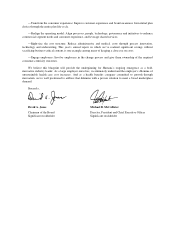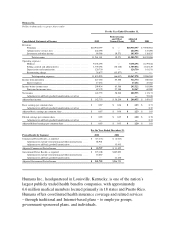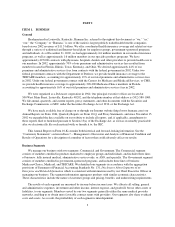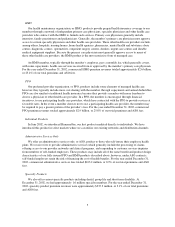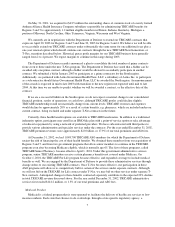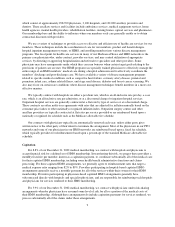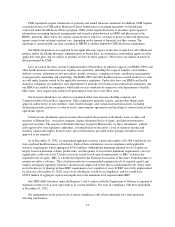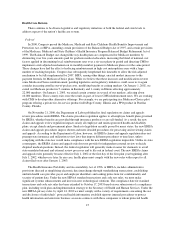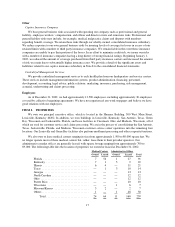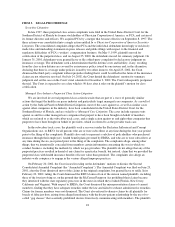Humana 2002 Annual Report Download - page 15
Download and view the complete annual report
Please find page 15 of the 2002 Humana annual report below. You can navigate through the pages in the report by either clicking on the pages listed below, or by using the keyword search tool below to find specific information within the annual report.which consist of approximately 298,700 physicians, 3,100 hospitals, and 122,000 ancillary providers and
dentists. These ancillary services and facilities include ambulance services, medical equipment services, home
health agencies, mental health providers, rehabilitation facilities, nursing homes, optical services and pharmacies.
Our membership base and the ability to influence where our members seek care generally enable us to obtain
contractual discounts with providers.
We use a variety of techniques to provide access to effective and efficient use of health care services for our
members. These techniques include the coordination of care for our members, product and benefit designs,
hospital inpatient management systems, or HIMS, and enrolling members into various disease management
programs. The focal point for health care services in many of our Medicare+Choice and HMO networks is the
primary care physician who, under contract, provides services, and may control utilization of appropriate
services, by directing or approving hospitalization and referrals to specialists and other providers. Some
physicians may have arrangements under which they can earn bonuses when certain target goals relating to the
provisions of patient care are met. Our HIMS programs use specially trained physicians to effectively manage the
entire range of an HMO members’ medical care during a hospital admission and to effectively coordinate the
members’ discharge and post-discharge care. We have available a variety of disease management programs
related to specific medical conditions such as congestive heart failure, coronary artery disease, prenatal and
premature infant care, asthma related illness, end stage renal disease, diabetes and breast cancer screening. We
also may focus on certain rare conditions where disease management techniques benefit members in a more cost
effective manner.
We typically contract with hospitals on either a per diem rate, which is an all-inclusive rate per day, a case
rate, which is an all-inclusive rate per admission, or at a discounted charge for inpatient hospital services.
Outpatient hospital services are generally contracted at a flat rate by type of service or at a discounted charge.
These contracts are often multi-year agreements with rates that are adjusted for inflation annually based on the
consumer price index or other nationally recognized inflation index. Outpatient surgery centers and other
ancillary providers are typically contracted at flat rates per service provided or are reimbursed based upon a
nationally recognized fee schedule such as the Medicare allowable fee schedule.
Our contracts with physicians typically are automatically renewed each year, unless either party gives
written notice to the other party of their intent to terminate the arrangement. Most of the physicians in our PPO
networks and some of our physicians in our HMO networks are reimbursed based upon a fixed fee schedule,
which typically provides for reimbursement based upon a percentage of the standard Medicare allowable fee
schedule.
Capitation
For 8.8% of our December 31, 2002 medical membership, we contract with hospitals and physicians to
accept financial risk for a defined set of HMO membership. In transferring this risk, we prepay these providers a
monthly fixed-fee per member, known as a capitation payment, to coordinate substantially all of the medical care
for their capitated HMO membership, including some health benefit administrative functions and claims
processing. For these capitated HMO arrangements, we generally agree to reimbursement rates that target a
medical expense ratio ranging from 82% to 89%. Providers participating in hospital-based capitated HMO
arrangements generally receive a monthly payment for all of the services within their system for their HMO
membership. Providers participating in physician-based capitated HMO arrangements generally have
subcontracted directly with hospitals and specialist physicians, and are responsible for reimbursing such hospitals
and physicians for services rendered to their HMO membership.
For 5.9% of our December 31, 2002 medical membership, we contract with physicians under risk-sharing
arrangements whereby physicians have assumed some level of risk for all or a portion of the medical costs of
their HMO membership. Although these arrangements do include capitation payments for services rendered, we
process substantially all of the claims under these arrangements.
9


